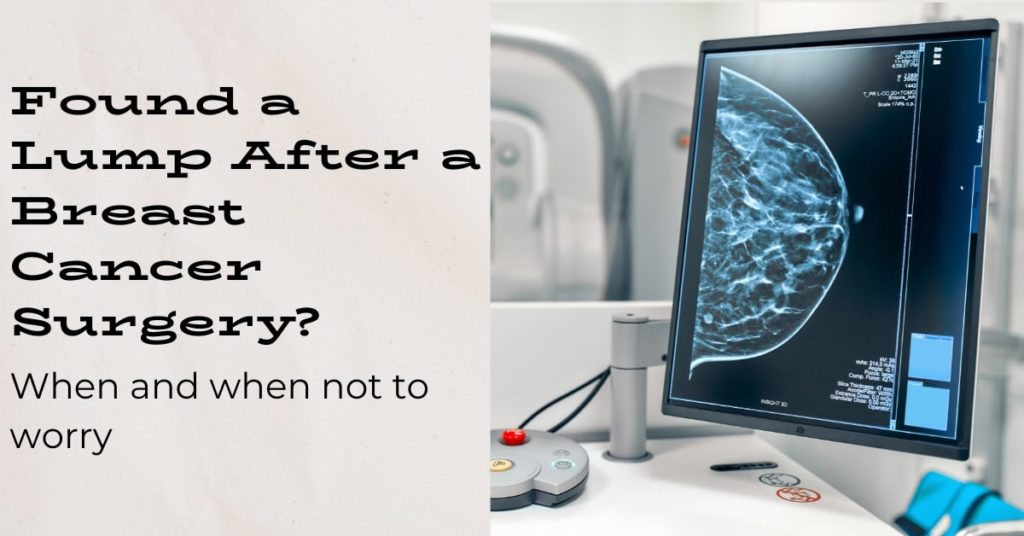After finally getting through the emotional rollercoaster of undergoing breast cancer surgery, the last thing you’d want to find is yet another lump. Without a doubt, this can be a scary situation for many women, but the reality is that there are so many factors to consider. It’s not fair for anyone to assume the worst.
It may be as simple as a scar tissue lump after mastectomy- which is actually common. Here are some of the many possible explanations besides recurring cancer.
Fat Necrosis
It may have an unsettling name, but it’s totally benign! It is basically a buildup of dead fat tissue that occurs due to injury and lack of proper blood supply after surgery. It’s always firm and round, but there may be multiple lumps involved. Usually, it’s painless, but sometimes, it may be tender, bruised, or red- making it appear more worrying. There are some cases where it causes the nipple to indent, which is something associated with breast cancer.
Fat necrosis can be difficult to figure out since it can look like cancer on scans, so other diagnostic measures should be taken. Though usually, it’s spotted on mammograms and ultrasounds, a needle core biopsy is needed since scans can sometimes inaccurately diagnose it as cancer. The great thing about fat necrosis is that most women do not need treatment of any kind. Surgery to remove it might be recommended if it causes discomfort or if it gets too large. Luckily, removal surgeries are relatively simple and only leave a small scar.
Fibrosis
Breast fibrosis or fibrocystic breast disease occurs in women who haven’t undergone surgery; this is exactly what causes pain and tenderness during certain times of the menstrual cycle. It can make your breasts feel lumpy and firm to the touch. Though, in women who’ve had breast cancer surgery of some kind, or have undergone radiation, fibrosis can be caused by a lack of lymphatic flow and inflammation. With fibrosis, you might experience redness and firmness alongside slight pain.
Since fibrosis is considered perfectly normal, there isn’t much treatment needed besides finding supportive bras and taking over-the-counter medication. Though, there are many natural, at-home treatments that can relieve symptoms.
Cysts
For women who’ve had breast cancer treatment, fibrocystic changes should be observed a bit more carefully. Some of the lumpiness of fibrosis can be made of fluid-filled cysts, which are usually benign. The cysts that have a small chance of being cancerous are complex cysts. These have thicker outer walls and should be biopsied to rule out cancer.
Seromas
Seroma also sounds concerning, but these often heal on their own. After surgery or radiation, a collection of pale or yellowish fluid called serous fluid can build up and cause a soft area of swelling. This fluid isn’t pus or blood, but it’s made of mostly proteins and water. Seromas develop immediately after surgery or show up weeks later.
After a while, the fluid can be reabsorbed into the body, but sometimes, a needle is needed to take it out. These don’t increase the risk of recurring cancer, but the scar tissue it leaves after healing can be misdiagnosed as cancer later on in a mammogram. One concern with seromas is that it increases the risk of developing lymphedema.
Suture Granulomas
These growths are clusters of immune cells that can appear along surgical sutures or stitches. Although they can look red and swollen, they usually go away on their own with anti-inflammatory medications. It’s one type of scar tissue lump after mastectomy.
Silicone Granulomas
One of the risks of breast reconstruction is the development of silicone granulomas. These can happen especially if the implant leaks silicone gel. Granulomas grow in reaction to this foreign substance in your body, but just like suture granulomas, they are harmless. What is more dangerous is to have leaking silicone in your breasts; they can pose a risk to your lymph nodes. These granulomas and the silicone can and should be removed with surgery.
What to Know About Recurring Breast Cancer
If you’ve had a lumpectomy, cancer can develop in the remaining breast tissue. A scar tissue lump after mastectomy can be one ordeal, but recurring cancer in the skin or the chest wall is still a possibility. Many of the signs and symptoms of cancer are the same as kinds of benign growths. Still, if you have any new changes in your breast, it’s best to get a professional opinion.
New redness, firmness, unusual swelling, skin changes, nipple discharge, and scar thickening are all reasons to book an appointment with your doctor. If cancer comes back in the lymph nodes, it will usually be located in your armpits, near your collarbone, or in the neck. At least with the previous experience you have with cancer, you can be better prepared and on the lookout for early warning signs.
